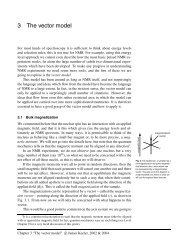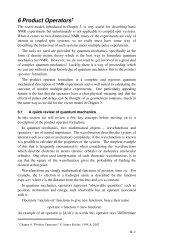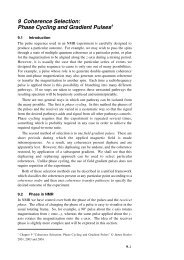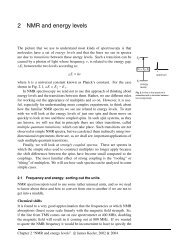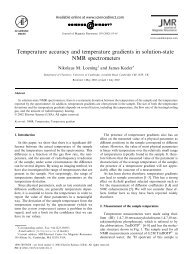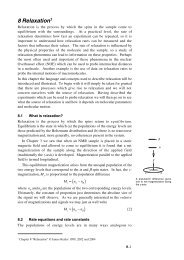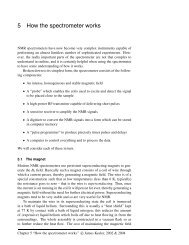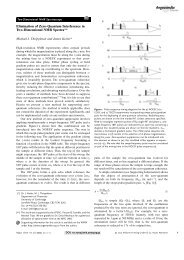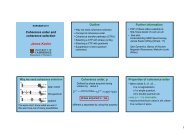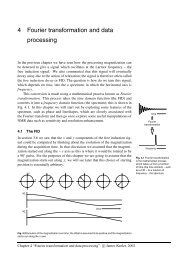Phase Cycling and Gradient Pulses - The James Keeler Group
Phase Cycling and Gradient Pulses - The James Keeler Group
Phase Cycling and Gradient Pulses - The James Keeler Group
You also want an ePaper? Increase the reach of your titles
YUMPU automatically turns print PDFs into web optimized ePapers that Google loves.
the CYCLOPS sequence in section 9.2.6; in both cases the receiver phase<br />
follows the phase of the desired magnetization or coherence.<br />
We now need to see if this four step phase cycle eliminates the signals from<br />
other pathways. As an example, let us consider a pathway with<br />
∆p = 2, which might arise from the transfer from coherence order –1 to +1.<br />
Again we draw up a table to show the phase experienced by a pathway with ∆p<br />
= 2, that is computed as – (2)φ<br />
step<br />
pulse<br />
phase<br />
phase shift experienced by<br />
transfer with ∆p = 2<br />
equivalent<br />
phase<br />
rx. phase to<br />
select ∆p = –3<br />
difference<br />
1 0 0 0 0 0<br />
2 90 –180 180 270 270 – 180 = 90<br />
3 180 –360 0 180 180 – 0 = 180<br />
4 270 –540 180 90 90 – 180 = –90<br />
As before, the equivalent phase is simply the phase in column 3 reduced to the<br />
range 0 to 360°. <strong>The</strong> fifth column shows the receiver (abbreviated to rx.)<br />
phases determined above for selection of the transfer with ∆p = –3. <strong>The</strong><br />
question we have to ask is whether or not these phase shifts will lead to<br />
cancellation of the transfer with ∆p = 2. To do this we compute the difference<br />
between the receiver phase, column 5, <strong>and</strong> the phase shift experienced by the<br />
transfer with ∆p = 2, column 4. <strong>The</strong> results are shown in column 6, labelled<br />
"difference". Looking at this difference column we can see that step 1 will<br />
cancel with step 3 as the 180° phase shift between them means that the two<br />
signals have opposite sign. Likewise step 2 will cancel with step 4 as there is a<br />
180° phase shift between them. We conclude, therefore, that this four step<br />
cycle cancels the signal arising from a pathway with<br />
∆p = 2.<br />
An alternative way of viewing the cancellation is to represent the results of<br />
the "difference" column by vectors pointing at the indicated angles. This is<br />
shown below; it is clear that the opposed vectors cancel one another.<br />
0°<br />
step 1 2 3 4<br />
difference 0°<br />
90° 180° 270°<br />
Next we consider the coherence transfer with ∆p = +1. Again, we draw up<br />
the table <strong>and</strong> calculate the phase shifts experience by this transfer, which are<br />
given by – (+1)φ = –φ.<br />
9–22



